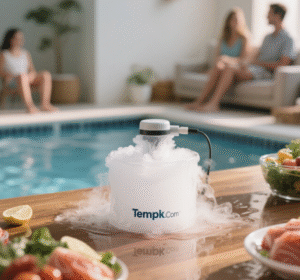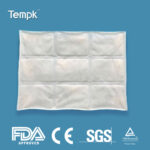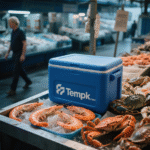Usando dry ice on pool decks can create eye‑catching fog, but too much CO₂ turns the water—and the party—dangerous. At 30 lb in a 10 m indoor pool, gas levels can exceed 12 000 ppm in two minutes—well above OSHA’s 5 000 ppm limit. This guide shows you how to wow guests while staying inside the 2025 Model Aquatic Health Code (MAHC) rules.

This Guide Answers
-
How much dry ice on pool is safe per gallon of water?
-
Which pool types handle fog best—indoor or outdoor?
-
How does dry ice on pool change water pH, chlorine, and pumps?
-
What 2025 regulations and tech protect guests from CO₂?
How Much Dry Ice on Pool Creates Fog Without Danger?
Stay below 1 lb of dry ice per 500 gal of water in outdoor pools, and 0.25 lb per 500 gal indoors. This keeps airborne CO₂ under 5 000 ppm in most scenarios, according to 2024 MAHC Annex simulations.
Opening doors or running exhaust fans doubles the safe limit. Never add chunks larger than 2 inches; smaller pieces sublimate evenly and reduce sudden plumes.
Why the Limit Exists
Past tragedies show that dumping 50 lb of dry ice on pool surfaces can trap swimmers under an oxygen‑poor CO₂ layer; three deaths in Moscow in 2020 highlighted the risk.
| Pool Volume (gal) | Max. Dry Ice (exterior) | Max. Dry Ice (indoor) | Practical Impact |
|---|---|---|---|
| 10 000 | 20 lb | 5 lb | Party‑fog effect without respiratory hazard |
| 20 000 | 40 lb | 10 lb | Suitable for hotel resort shows |
| 50 000 | 100 lb | 25 lb | Large water‑park lagoon events |
Quick‑Action Tips
-
Stir gently with a skimmer to spread pellets and avoid CO₂ pockets.
-
Vent early: run roof fans 10 min before adding dry ice on pool.
-
Use tongs and gloves: surface frost burns at –78 °C in seconds.
Estudio de caso: A 2025 Las Vegas resort added 15 lb of pellets to a 25 000‑gal open‑air pool; CO₂ stayed below 2 500 ppm at deck level, and fog lingered 18 minutes—verified by portable sensors.
Does Dry Ice on Pool Affect Water Chemistry and Equipment?
Yes—CO₂ temporarily drops pH by up to 0.3 and can trigger short‑term chlorine demand. Pumps tolerate it, but rapid gas bubbles may air‑lock older sand filters.
-
Balance first: keep alkalinity ≥80 ppm to buffer pH swings.
-
Run circulation at 50 % during fog; full speed sucks pellets into skimmers.
-
Shock 8 h later with 10 ppm bleach to recover chlorine reserve.
Fog vs. Filtration: What Happens Inside the Plumbing?
Large pellets sink, then shoot bubbles into return lines, causing cavitation noise. Switching to 3 mm “snow” minimizes suction. An Illinois water‑park study logged a 7 % drop in flow during 20 lb trials—well below pump safety thresholds.
pH Drop and Recovery Timeline
| Time After Fog | Average pH (7.4 baseline) | Your Takeaway |
|---|---|---|
| 0–15 min | 7.1 | Slightly acidic—safe for swimmers |
| 1 h | 7.25 | Natural off‑gassing begins |
| 4 h | 7.35 | Approaches baseline |
| 24 h | 7.4 | No lasting effect |
What Safety Rules Govern Dry Ice on Pool Events in 2025?
El 2024 MAHC Annex urges venue operators to cap CO₂ additions, post warning signs, and install at‑deck CO₂ monitors with 5 000 ppm alarms.
Local fire codes often mirror NFPA 55, classifying dry ice as a “refrigerated CO₂ solid” that needs 1 cfm of mechanical ventilation per pound used. Indoor events must log the mass added and keep an SDS on site.
-
Permitting: Some municipalities now require a one‑time “CO₂ fog waiver.”
-
Training: Staff must know frostbite first aid and evacuation signals.
-
Recordkeeping: Document pounds of dry ice on pool and CO₂ readings for 90 days.
Failure to comply can bring US$5 000 fines and closure orders.
2025 Trends in Dry Ice on Pool Entertainment
Smart CO₂ sensors now pair with phone apps, pinging you when deck levels near 4 000 ppm. Pellet suppliers offer reclaimed‑CO₂ “fog kits” that include vent fans and pH test strips—rentals rose 34 % in 2024. Mientras tanto, aerogel‑lined pellet buckets slow sublimation by 20 %, saving roughly US$0.40 per lb at summer temps.
Latest Highlights
-
Color‑shift pellets: Turn blue when fully sublimated, letting staff skim debris fast.
-
AI ventilation control: Adjusts fan speed to hold CO₂ under OSHA limits.
-
Eco‑reclaimed dry ice: Cuts event carbon footprint by 15 % vs. virgin CO₂.
Market insight: Party‑fog rentals are expected to top US $185 M by 2027, fueled by resorts and e‑sports arenas.
Preguntas frecuentes
Can swimmers stay in the pool while dry ice is fogging?
No. Wait until pellets finish bubbling; CO₂ displaces oxygen at the water surface and can suffocate.
Will dry ice stain pool liners or tiles?
No coloration occurs, but pellets can crack thin vinyl if they settle; keep them moving with a skimmer.
Does dry ice on pool kill algae?
Only briefly by lowering pH; it’s not a reliable sanitizer—stick to chlorine or UV.
Key Takeaways
-
Keep dry ice on pool under 1 lb per 500 gal outdoor, 0.25 lb indoor.
-
Ventilation and CO₂ monitors are mandatory under the 2024 MAHC Annex.
-
Expect a 0.3‑point pH dip; rebalance alkalinity beforehand.
-
Use gloves, tongs, and warning signs to avoid burns and gas pockets.
Siguientes pasos
-
Run the Fog Calculator above before your next event.
-
Download our MAHC‑compliant checklist to show inspectors.
-
Book a free fog‑safety consult with Tempk’s aquatic team.
About Tempk
We design reclaimed‑CO₂ fog kits, smart CO₂ sensors, and aerogel transport buckets tested under NFPA 55 and MAHC standards. Our engineers can map your pool volume and ventilation to guarantee safe, Instagram‑worthy fog.
Ready to wow guests safely? Reach out for a custom quote today.























